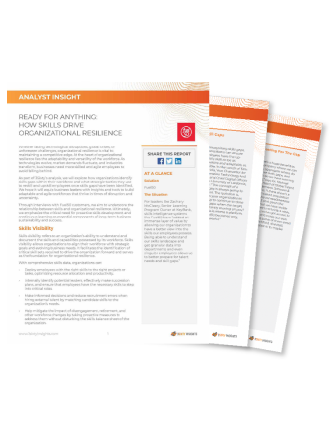If you’re looking to hire new employees this year, it may be time to reevaluate your hiring strategy and look at internal mobility. Research shows that recruitment will be an ongoing challenge for years to come, with the tight labor market and talent shortage to blame.
Indeed & Glassdoor’s Hiring & Workplace Trends Report 2023 highlights the tight labor supply as the #1 long-term challenge for employers today. While the issue peaked after COVID-19, the report outlines “deep-seated and long-term supply dynamics” as the driving force that has created a significant gap between employer demand for new hires and the supply of candidates.
With economic uncertainty and the impact of inflation also a top concern, organizations are scrambling for a solution. Some are opting for a quick fix by avoiding new hires to reduce costs ahead of the predicted recession, however, this could do more damage than good in the long term. Talent gaps often result in existing employees having to pick up the extra work, leading to burnout, stress, and lower levels of productivity.
The key to conquering the tight labor market lies in retaining your existing staff and developing them to reach their full potential. So, what does this mean for organizations needing to fill roles when candidates are scarce and competition for talent is fierce? It’s time to start sourcing talent within your organization and encouraging internal talent mobility.
Give employees the opportunity to grow
According to Forbes, focusing on retaining top talent is crucial for organizations looking to thrive in unpredictable work environments. And with plenty of job vacancies to choose from, many employees are likely asking themselves whether they should stay or leave their current jobs.
A recent report published by Cornerstone and Lighthouse Research & Advisory found that employees who do not have visibility into internal career opportunities are 61% more likely to have plans to quit their job, and over 50% say they are more likely to stay if they had the opportunity to explore internal career opportunities.
On top of that, research from McKinsey & Company found that the primary reason workers quit between April 2021 and April 2022 was a lack of career development. The same study also found that “almost three-quarters of employed respondents believe that it would not be difficult to find a job that pays the same or better, with the same or better benefits.”
There are numerous reports that come to the same conclusion, making it crystal clear – if you’re not offering your employees opportunities to develop or grow within your organization, you’re at great risk of them leaving. Bryan Hancock, a Partner at McKinsey reiterates this point:
There are a lot of people who are stagnant in their jobs. They don’t see the development opportunity through formal or informal programs, and they’re saying, ‘if I’m not growing, I’m going.
Fuel50 research explains that employees need a clear developmental path to remain motivated in their roles. Providing them with that visibility offers them security in knowing there is a road to move forward and progress in their career which enables them to envision a future within your organization.
Embracing internal hiring offers employees a chance to grow, which not only helps increase retention, engagement, and agility, but also reduces the cost of external hiring, and develops high-performing talent that will help your business succeed – something all organizations are desperately seeking in today’s work climate.

Start thinking about your existing workforce first
If you haven’t implemented an internal mobility program yet, now is the time to start planning. An aging workforce, lower fertility rates, and changes in work preferences are all contributing factors to a continuing reduced talent pool. United Nations expects there to be 95 million fewer people in the labor force by 2050. So having a plan in place now is vital for building an agile workforce that’s prepared for the future.
According to Fuel50’s Best Practice Guide to Internal Talent Mobility, organizations tend to forget about considering talent within their own workforce when hiring for roles, and often make the mistake of focusing on “counting heads rather than making heads count”.
We forget about all available talent in our full and extended workforce, we lack a complete and timely line of sight to where they are and the skills and capabilities they offer, and we tend to focus on counting heads more than we focus on making heads count. – A Best Practice Guide to Internal Talent Mobility, Fuel50
Encouraging internal moves across your organization enables you to fill talent gaps with existing employees who already know the ins and outs of your business. As opposed to an external hire, an internal recruit means there’s no need for lengthy training periods, added remuneration costs, or extended delays in filling vacant roles.
It’s imperative to remember that building a resilient and agile workforce isn’t about just filling jobs, it’s about finding the right skills and capabilities to sustain and future-proof the business. Internal mobility promotes a more fluid mindset around talent and creates a culture that values talent sharing, learning, and development. And if employees are demanding more career development and growth opportunities, why not give it to them?
High-performance organizations are in fact twice as likely to prioritize talent mobility compared to low-performance organizations. And according to Forbes, internal talent mobility programs have had a proven positive impact on employee retention, and 60% reduction in attrition where a talent marketplace is used by employees.
Unlock talent mobility for future success
A new approach to recruitment that focuses on developing existing employees for key roles across the business instead of external hires will be essential in the current labor market. You’ll soon find that the candidates you’ve been looking for may already be working for you.
An effective internal mobility program that is built for long-term success is backed by a skills-powered talent marketplace that enables internal talent visibility, workplace transparency, and a clear view of the skills and capabilities your workforce has to offer. Once you have that under your belt, you will be able to fill skills gaps more effectively and build talent pipelines to secure the future success of your organization and employees.













